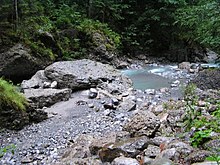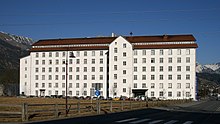Bürs
|
Bürs
|
||
|---|---|---|
| coat of arms | Austria map | |
|
|
||
| Basic data | ||
| Country: | Austria | |
| State : | Vorarlberg | |
| Political District : | Bludenz | |
| License plate : | BZ | |
| Surface: | 24.61 km² | |
| Coordinates : | 47 ° 8 ' N , 9 ° 48' E | |
| Height : | 570 m above sea level A. | |
| Residents : | 3,362 (January 1, 2020) | |
| Population density : | 137 inhabitants per km² | |
| Postal code : | 6706 | |
| Area code : | 05552 | |
| Community code : | 8 01 06 | |
| NUTS region | AT341 | |
| Address of the municipal administration: |
Dorfplatz 5 6706 Bürs |
|
| Website: | ||
| politics | ||
| Mayor : | Georg Bucher ( SPÖ ) | |
|
Local council : (2015) (24 members) |
||
| Location of Bürs in the Bludenz district | ||
 Bürs - village center seen from the north |
||
| Source: Municipal data from Statistics Austria | ||
Bürs is a community with 3362 inhabitants (as of January 1, 2020) at an altitude of 570 meters and belongs to the Bludenz district in Vorarlberg .
geography
The municipality is located in the westernmost state of Austria, Vorarlberg, at an altitude of 555–2643 m above sea level. M. and has an area of 24.6 km². 46.0% of the area is forested, 16.0% of the area of the Alps.
politics
The community council consists of 24 members. The composition after the municipal council and mayoral elections in 2015 is:
- Mayor Georg Bucher - Social Democrats and non-party members: 12 seats
- Gerd Kaufmann - Bürser People's Party and Independent: 7 mandates
- Active for Bürs: 4 mandates
- FPÖ Bürs - Bürser Freiheitliche: 1 mandate
Mayor is Georg Bucher from the Social Democratic Party of Austria. He was confirmed in office in the direct mayor election 2015 with 57.32% of the votes. Bürs is currently (along with St. Gallenkirch ) one of two Vorarlberg municipalities that is headed by an SPÖ mayor.
history
The village "Puire" with a church was mentioned as early as 820–830. In the Middle Ages, iron mining also played a certain role in Bürs (1355 documentary reference to the “Ysenberg zu Bürs”). Two castles were also built in the Bürs area, the Bürs Fortress (destroyed around 1405) and Holenegg Castle (later Rosenegg Castle).
In 1548, Bürs became an independent municipality when it was separated from Bludenz . At this point in time, the now independent communities Bürserberg and Brand also belonged to the community area. The place was previously repeatedly hit by flood disasters, e.g. B. 1762 and 1910 through the Alvierbach .
From 1804 large mudslides in the Schesatobel led to the largest mudflow in Europe; the demolition is still visible from afar. With extensive torrent barriers since the turn of the century, the dangers could be contained to such an extent that after 1950 the settlement could expand towards the Schesatobel. Between 1951 and 1991 the number of houses in Bürs more than doubled.
In 1969, part of the Arlberg expressway was built in the Bürs municipality . In the seventies the place received a new parish church, a school, a sports and a shopping center, in 1987 a new community center. 1991 New construction of Brandnerstrasse as a bypass.
Population development

The proportion of foreigners at the end of 2002 was 14.5 percent.
From 1981 to 2001 the migration balance was close to zero, but the birth balance was very positive, which led to a growth in the community. The birth rate declined until 2011, so that the population remained almost constant.
economy
Agriculture was hit hard at the beginning of the 19th century by mudsliding the best soils on the Schesatobel alluvial cone. The settlement of industry was therefore very welcome, especially at this time. 1826 Foundation of the Getzner, Mutter & Cie. ; meanwhile further developed with colored weaving and foundation of Getzner-Chemie. Development into a relatively prosperous industrial village also through the settlement of several smaller industrial and commercial enterprises from various sectors in the original pastureland between Bludenz and Bürs. In addition, increased trading business (since 1976 with Interspar).
In 2010 there were fourteen agricultural and forestry operations in Bürs, seven of which were full-time farms. In the secondary economic sector according to ÖNACE , 608 people were employed in 28 companies, mainly in the manufacture of goods, in construction, but also 22 people in mining. The tertiary economic sector employed 1,629 people in 219 companies. Most of the employees were in trade, followed by social and public services (as of 2011).
In the substation Bürs the world's oldest starts high-voltage line , the north-south line . This three-phase high-voltage transmission , operated for the first time with 220 kV , was built by Vorarlberger Illwerke AG between 1924 and 1929. Another 220/380 kV line, which leads from Bürs to the German border and on to the Dellmensingen substation southwest of Ulm, was added by Energie -versorgung Schwaben at the end of the 1950s.
Scenic features
In the Bürser Gorge at the entrance to the Brandnertal , which is partially accessible by a footbridge , a unique landscape design from the Ice Age (Bürser conglomerate , moraines , boulders ) can be viewed . The mountainous area has a largely intact nature and an unusual habitat diversity (z. B. United habitats Ochsenälpele nuns Alpe and Sarotlatal ).
Sports
The largest and best-known sports club in Bürs is the SK Bürs , a football club founded in 1971 and with around 300 members. The club plays its home games at the "uf dr Schesa" sports field, which is located in the "Schesa" district.
Culture and sights
- Parish church of Bürs : The first church was built here in 1347 and a new building followed around 1480, of which the choir has still been preserved. This Gothic building from the 15th century was converted to Baroque style in 1768 and after a fire in 1843 the nave was added and extended. The high altar is a neo-Gothic structure (1886) with parts of the former late Gothic winged altar from 1480. The stations of the cross are from Josef Anton Bertle from Schruns (1846).
- Parish Church of Mary, Queen of Peace (Friedenskirche). This church in the settlement area in the west of the village was built from 1968 to 1973 according to plans by Walter Moser .
- In Bürs there are a few remarkable Walgau houses and also old semi-detached houses as well as industrial buildings from the 19th century (spinning and weaving mills of the Getzner textile works and workers' houses).
- Rosenegg Castle : This medieval castle complex was built in the middle of the 13th century. During the Appenzell War, the castle was destroyed in 1405 and then rebuilt. However, it fell into disrepair before 1600. In the years 1898 to 1900 the keep was rebuilt in the neo-Gothic style and in 1939 it was rebuilt and expanded.
- Lünerseefabrik: The spinning mill is located at the entrance to the village, between Zimbapark and Lünerseepark . The building was built in 1836/38, expanded in 1850 and 1856/57. This six-story industrial building was home to the spinning and weaving mills of Getzner, Mutter & Cie until the 1980s , and the operation was shut down in 1985. Today the building is a listed building . The facade design with 20 window axes on the long side and 4 on the transverse side corresponds to the simple industrial construction method of the time - with smooth plastered surfaces and small-chipped baroque wooden windows. Today an industrial park has been built in this area - the factory chimney was preserved as an industrial signal and reinterpreted by a light installation by the artist Brigitte Kowanz .
Web links
- 80106 - Bürs. Community data, Statistics Austria .
Individual evidence
- ^ Statistics Austria, A look at the municipality of Bürs, population development. Accessed March 31, 2019 .
- ^ Statistics Austria, A look at the municipality of Bürs, agricultural and forestry operations. Accessed March 31, 2019 .
- ^ Statistics Austria, A look at the community of Bürs, workplaces. Accessed March 31, 2019 .
- ^ Statistics Austria, A look at the community of Bürs, employees. Accessed March 31, 2019 .
- ↑ SK Bürs . SK Bürs website. Retrieved May 30, 2015.













